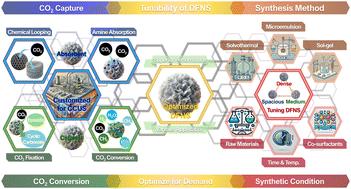当前位置:
X-MOL 学术
›
Chem. Soc. Rev.
›
论文详情
Our official English website, www.x-mol.net, welcomes your
feedback! (Note: you will need to create a separate account there.)
The potential utility of dendritic fibrous nanosilica as an adsorbent and a catalyst in carbon capture, utilization, and storage
Chemical Society Reviews ( IF 40.4 ) Pub Date : 2024-09-16 , DOI: 10.1039/d4cs00564c Sam Yeol Lim, Sherif A. Younis, Ki-Hyun Kim, Jechan Lee
Chemical Society Reviews ( IF 40.4 ) Pub Date : 2024-09-16 , DOI: 10.1039/d4cs00564c Sam Yeol Lim, Sherif A. Younis, Ki-Hyun Kim, Jechan Lee

|
Anthropogenic emissions of greenhouse gases (GHG; e.g., CO2) are regarded as the most critical cause of the current global climate crisis. To combat this issue, a plethora of CO2 capture, utilization, and storage (CCUS) technologies have been proposed and developed based on a number of technical principles (e.g., post-combustion capture, chemical looping, and catalytic conversion). In this light, the potential utility of dendritic fibrous nanosilica (DFNS) materials is recognized for specific CCUS applications (such as adsorptive capture of CO2 and its catalytic conversion into a list of value-added products (e.g., methane, carbon monoxide, and cyclic carbonates)) with the highly tunable properties (e.g., high surface area, pore volume, multifunctional surface, and open pore structure). This review has been organized to offer a comprehensive evaluation of the approaches required for tuning the textural/morphological/surface properties of DFNS (based on multiple synthesis and modification scenarios) toward CCUS applications. It further discusses the effects of such approaches on the properties of DFNS materials in relation to their CCUS performance. This review is thus expected to help develop and implement advanced strategies for DFNS-based CCUS technologies.
中文翻译:

树枝状纤维纳米二氧化硅在碳捕获、利用和储存中作为吸附剂和催化剂的潜在用途
温室气体的人为排放(GHG;例如,CO2)被认为是当前全球气候危机的最关键原因。为了解决这个问题,已经根据许多技术原理(例如,燃烧后捕获、化学循环和催化转化)提出和开发了大量的 CO2 捕获、利用和封存 (CCUS) 技术。有鉴于此,树枝状纤维纳米二氧化硅 (DFNS) 材料的潜在用途被公认为用于特定的 CCUS 应用(例如吸附捕获 CO2 并将其催化转化为一系列增值产品(例如甲烷、一氧化碳和环状碳酸盐)),具有高度可调的性能(例如、高表面积、孔体积、多功能表面和开孔结构)。本综述旨在对调整 DFNS 的纹理/形态/表面特性(基于多种合成和修饰场景)所需的方法进行全面评估,以实现 CCUS 应用。它进一步讨论了这种方法对 DFNS 材料性能与其 CCUS 性能的关系。因此,本综述有望帮助开发和实施基于 DFNS 的 CCUS 技术的高级策略。
更新日期:2024-09-21
中文翻译:

树枝状纤维纳米二氧化硅在碳捕获、利用和储存中作为吸附剂和催化剂的潜在用途
温室气体的人为排放(GHG;例如,CO2)被认为是当前全球气候危机的最关键原因。为了解决这个问题,已经根据许多技术原理(例如,燃烧后捕获、化学循环和催化转化)提出和开发了大量的 CO2 捕获、利用和封存 (CCUS) 技术。有鉴于此,树枝状纤维纳米二氧化硅 (DFNS) 材料的潜在用途被公认为用于特定的 CCUS 应用(例如吸附捕获 CO2 并将其催化转化为一系列增值产品(例如甲烷、一氧化碳和环状碳酸盐)),具有高度可调的性能(例如、高表面积、孔体积、多功能表面和开孔结构)。本综述旨在对调整 DFNS 的纹理/形态/表面特性(基于多种合成和修饰场景)所需的方法进行全面评估,以实现 CCUS 应用。它进一步讨论了这种方法对 DFNS 材料性能与其 CCUS 性能的关系。因此,本综述有望帮助开发和实施基于 DFNS 的 CCUS 技术的高级策略。


















































 京公网安备 11010802027423号
京公网安备 11010802027423号